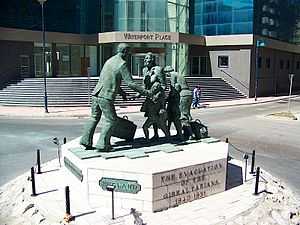Tommy Finlayson
| Tommy Finlayson | |
|---|---|
| Born |
Thomas James Finlayson 1 May 1938 Gibraltar |
| Residence | 13 Merlot House, Vineyards, Gibraltar |
| Nationality | British (Gibraltarian) |
| Citizenship | British |
| Education | Gibraltar Grammar School |
| Alma mater | University of Edinburgh |
| Occupation |
Teacher Archivist Cricketer |
| Employer | Government of Gibraltar |
| Known for |
Literary works on the history of Gibraltar Chairman of the Gibraltar Cricket Association |
| Notable work | The Fortress Came First |
| Home town | Gibraltar |
| Children | 2 daughters |
| Relatives | Clive Finlayson (brother), Director of the Gibraltar Museum |
| Awards |
Member of the British Empire ICC Lifetime Service Award (2008) |
Thomas James Finlayson MBE, commonly known as Tommy Finlayson (Gibraltar, 1 May 1938),[1] is a Gibraltarian historian. He is also a former cricketer and archivist of the Gibraltar Archives.[2]
He is the eldest brother of Clive Finlayson, the director of the Gibraltar Museum.[3]
Early life

Tommy Finlayson was born in Gibraltar on 1 May 1938. His family, of Scottish descent, have been established on The Rock since the early 19th century.[3] When World War II broke out he was evacuated, as was most of the civilian population of Gibraltar, with his family across the strait to French Morocco. Only a few weeks later, following the defeat of France and the armistice with Germany, the French authorities expelled the evacuees which the War Office then decided to transfer to London via Gibraltar. Finlayson and his family were taken to London aboard the Athlone Castle in July 1940. They lived in the Evacuee Centre at the Empire Pool in Wembley until they were once again relocated to a camp in County Antrim, Northern Ireland in 1944. Still a young boy, Finlayson attended the Gibraltar Grammar School following his repatriation to The Rock, once the war had ended. He later studied at the University of Edinburgh where he obtained an honours MA in history.[1]
Professional career
Finlayson later opted for a career in teaching, which he pursued in the United Kingdom and continued in Gibraltar upon his return in 1982.[4] In 1985, after 25 years of teaching, he was appointed archivist at the Gibraltar Archives by the Government of Gibraltar.[1] He maintained this position from the 1980s to the early 2000s.[5] At the same time, he wrote a number of books and articles on the contemporary history of Gibraltar. The most notable being The Fortress Came First. The story of the civilian population of Gibraltar during the Second World War (1990), which was described as "the definitive work on the wartime evacuation of Gibraltarian civilians".[6]
Historical works
His works have been devoted to the contemporary history of Gibraltar:[7]
- Finlayson, T.J. (1990). The Fortress Came First. The story of the civilian population of Gibraltar during the Second World War. United Kingdom: Gibraltar Books Ltd. ISBN 0-948466-12-X.
- Finlayson, T.J. (1996). Stories from the Rock. Gibraltar.
- Finlayson, T.J. Gibraltar Gives Thanks V.E. Day.
- Finlayson, T.J. (2011). Gibraltar Military Fortress or Commercial Colony. ISBN 978 1 919657-10-3.
Cricket
Finlayson has also taken an active part in Gibraltar cricket; as a player, Secretary and currently Chairman of the Gibraltar Cricket Association.[6] In March 2009 he received the 2008 Lifetime Service Award by International Cricket Council Europe in recognition of his services to cricket in Gibraltar.[8]
References
- ↑ 1.0 1.1 1.2 Finlayson, T.J. (1990). The Fortress Came First – The story of the civilian population of Gibraltar during the Second World War. United Kingdom: Gibraltar Books Ltd. ISBN 0-948466-12-X.
- ↑ Malta – Gibraltar Conference, 3 September 2002
- ↑ 3.0 3.1 Leguineche, Manuel (2002). Gibraltar (in Spanish). Barcelona: Planeta. p. 261. ISBN 84-08-04470-2.
- ↑ ICC Europe announces Regional Winners of Pepsi ICC Development Programme Awards for 2008
- ↑ E. G. Archer (2006). Gibraltar, identity and empire. Routledge. p. 207. ISBN 0-415-34796-3.
- ↑ 6.0 6.1 E. G. Archer (March 2003). "Imperial influences: gibraltarians, cultural bonding and sport" (PDF). Sport in Society 6 (1): 43–60. doi:10.1080/14610980312331271479.
- ↑ Local history books in stock in the Gibraltar Museum
- ↑ Press release, Government of Gibraltar, 11 March 2009.
| ||||||||||||||||||||||||||||||||||||||||||||||||||||||||||||||||||||||||||||||||||||||||||||||||||||||||||||||||||||||||
|